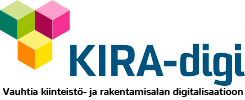Joint information management in the sector
The aim of KIRA-digi is to make the public construction and land use planning information readily accessible to everyone and to develop smoothly interoperable systems and harmonised practices for the sector.
Digitalisation principles of built environment
Ten principles have been created for the digitalisation of the built environment. As part of its KIRA-digi project, the Ministry of the Environment has specified the principles of digitalisation for the built environment, which were derived from the Government’s general digitalisation principles.
Click here to read the principles
More efficient use of shared identifiers
Interoperability in the sector will improve when the already existing shared technical and administrative identifiers are used in a clear and systematic manner. KIRA-digi promotes the use of shared identifiers.
The shared technical identifiers of the KIRA sector are related to the processes in land use, land use planning and building supervision. They include plan identifiers, permanent real estate identifiers, permanent building identifiers and apartment identifiers.
The shared administrative and financial identifiers and digital identifiers in the KIRA sector are used in numerous public administration processes and processes in the built environment and construction sector. These identifiers include construction site identifiers, business IDs, tax numbers and place of residence codes.
KIRA-digi report: Report on the construction site identifier
Sub-areas and elements of interoperability
The elements of interoperability will promote the building of a digital ecosystem and information flows. These standardised elements are a precondition for sustainable digitalisation of the built environment. The elements of interoperability concern objects, data storage and the sector in general.




